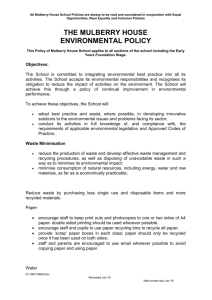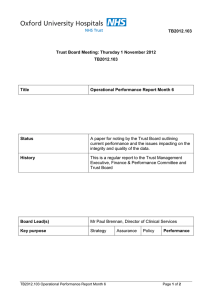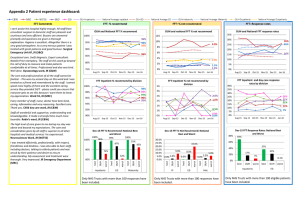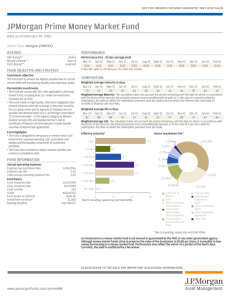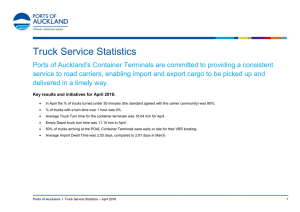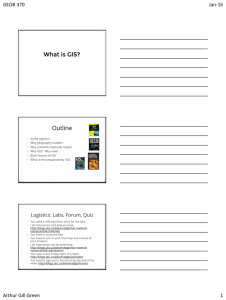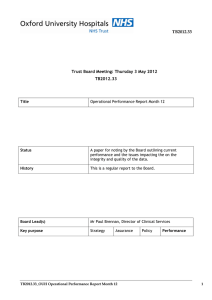Trust Board Meeting in Public: Wednesday 9 March 2016 TB2016.27 Title
advertisement
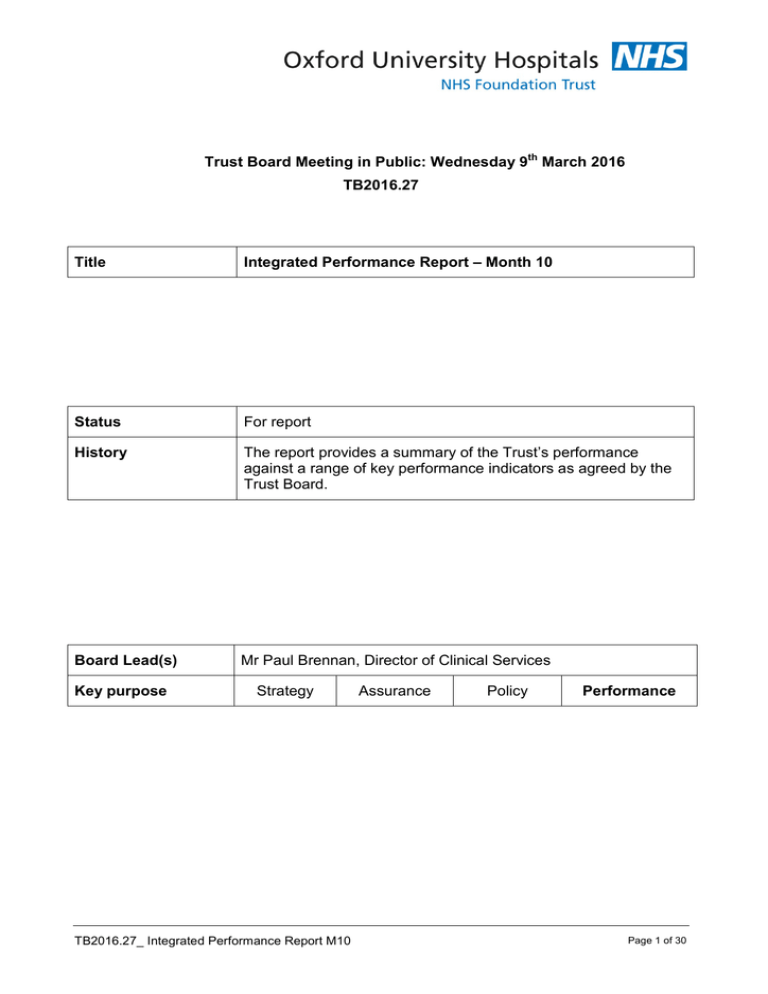
Trust Board Meeting in Public: Wednesday 9th March 2016 TB2016.27 Title Integrated Performance Report – Month 10 Status For report History The report provides a summary of the Trust’s performance against a range of key performance indicators as agreed by the Trust Board. Board Lead(s) Mr Paul Brennan, Director of Clinical Services Key purpose Strategy TB2016.27_ Integrated Performance Report M10 Assurance Policy Performance Page 1 of 30 Oxford University Hospitals NHS FT TB2016.27 Integrated Performance Report Month 10 Executive Summary 1. Key Highlights on performance • • • • • • • • 2. Areas of exception on performance • • • • • • 3. The percentage of adult inpatients that had a VTE risk assessment in December was 97.57% against the standard of 95%. Diagnostic waits over 6 weeks, 118 patients waited over 6 weeks at the end of January, achieving 0.95% against the standard of no more than 1% waiting over 6 weeks. The 18 week RTT Incomplete standard was achieved in January at 92.11% against the standard of 92%. Seven of the eight cancer standards were achieved in December 2015. MRSA bacteraemia; zero cases were reported in January. C Difficile, three cases were reported in January. Patients spending >=90% of time on stroke unit was 95.45% against a standard of 80% in January. Zero same sex accommodation breaches were reported at the end of January. Performance against the 4 Hour standard was 84.42% in January. Delayed Transfers of Care as a percentage of occupied beds is at 11.93% for January against the standard of 3.5%. In January 18 week RTT Admitted performance was 83.51% and Non-Admitted performance was 91.87% against the standards of 90% and 95% respectively. Cancer 2ww performance was at 92.22% against the standard of 93% for December. Staff turnover rate is 13.73%, which is 3.23% above the standard. Staff sickness absence rate was 3.5%, 0.5% above the standard. Key Standards 3.1. 18 Week RTT, A/E and Cancer 3.1.1. 4 Hour 95% standard: Performance in January was 84.42%. 3.1.2. 18 Week Referral to Treatment [RTT] performance: The RTT admitted standard was subject to an agreed plan fail in January with performance at 83.51% against the 90% target. The incomplete standard was achieved at 92.11% against the 92% target but the non-admitted standard was not achieved at 91.87% against the 95% target. 3.1.3. Seven of the eight Cancer Standards were achieved in December 2015 with the exception of the 2 week wait primarily due to patients choosing to delay treatment during the festive season. However the overall position for Q3 was achievement of all 8 standards across the quarter. 3.2. Activity 3.2.1. Delayed Transfers of Care continue to be a significant concern for the Trust with performance for January at 11.93% against a target of 3.5%. The monthly average within the OUH for January was 100 and 152 across the system. TB2016.27_ Integrated Performance Report M10 Page 2 of 30 Oxford University Hospitals NHS FT TB2016.27 Monitor Assessment 3.3. Whilst Monitor’s Access and Outcomes matrix operates on a quarterly basis (except for RTT) the Trust monitors performance against this matrix on a monthly basis. The Trust monthly score to date is set out below. May June July Aug Sept Oct Nov Dec Jan Score 1 0 0 1 2 2 1 2 1 Standards Not Achieved 62 day cancer - - 4 hour 4 hour 4 hour 62 day 62 day cancer screening 4 hour 4 hour 2ww cancer 4 hour Note: Target score is zero. Note: January figures exclude Cancer as figures awaited from Open Exeter. 3.4. The Q3 actual performance was a score of 1 as across the quarter the 62 day cancer screening and 2 week wait cancer standards were achieved. The forecast for Q4 is a score of 1. 3.5. The quarter scores are as follows: Q1 Q2 Q3 Score 1 1 1 Standards Not Achieved 4 Hour 4 Hour 4 Hour Q4 tbc Note: a score of zero equates to the highest level of performance and a score of 3 plus can lead to action. 4. ECIST Whole System Report 4.1. The Oxfordshire Health System has received a sign off letter from the Emergency Care Intensive Support Team for the Whole System Report. 5. Workforce 5.1. Turnover decreased from 13.9% in December to 13.73% in January and is 3.23% above the KPI target. Increasing substantive capacity remains a priority and initiatives to assist staff in their ability to remain employed in Oxford are being pursued in tandem. 6. Additional Appendices 6.1. The two reports attached in appendix 2 and 3 respectively, the Efficiency and Utilisation report focusing on length of stay, patient flow and detail on the delayed discharges. The Quarterly monitoring report has been added for completeness. 7. Recommendations The Trust Board is asked to receive the Integrated Performance Report for Month 10. Paul Brennan Director of Clinical Services March 2016 TB2016.27_ Integrated Performance Report M10 Page 3 of 30 ORBIT Reporting Trust Board Integrated Performance Report January 2016 At A Glance report Data Quality Indicator The data quality rating has 2 components. The first component is a 5 point rating which assesses the level and nature of assurance that is available in relation to a specific set of data. The levels are described in the box below. Rating Required Evidence 1 Standard operating procedures and data definitions are in place. 2 As 1 plus: Staff recording the data have been appropriately trained. 3 As 2 plus: The department/service has undertaken its own audit. 4 As 2 plus: A corporate audit has been undertaken. As 2 plus: An independent audit has been undertaken (e.g. by the Trust's internal or external auditors). 5 Escalation report Graph Legend Underachieving Standard Plan/ Target Current Year Performance Previous Year Performance The second component of the overall rating is a traffic-light rating to include the level of data quality found through any auditing / benchmarking as below Rating Green Data Quality Satisfactory Amber Data can be relied upon but minor areas for improvement identified. Red Unsatisfactory/significant areas for improvement identified. Page 4 of 30 Efficiency and Utilisation Report 2015-16 APPENDIX A: Efficiency and Utilisation IPR report Feb-16 Patients staying greater than 21 days and discharged in month 0.1 0.1 0.1 0.1 0.0 140 121 105 125 82 March 0.1 126 February November 0.1 149 October 0.1 129 August 0.1 111 July January Average Number of ward transfers Number of patients with more than 3 ward stays in one spell June December 2015-16 May 0.7 123 April OUH September * Excluding EAU,Discharge lounge, SEU, ITU( Adult, Neuro, Cardiac & Paeds) This indicator records the number of ward moves that are less clinically appropriate. Wards where a definitive clinical decision has been made to move the patient to, such as ITUs, Transfer Lounge, Emergency Admissions Units have been removed. November December January 20394 11725 9689 9675 5896 17985 10122 8656 8479 5649 20784 11915 9636 9313 5792 21746 11934 10771 9009 5922 21087 11842 9524 8726 5922 18647 10756 8612 8033 6312 19704 11223 9767 8435 5944 March October 20263 11536 9712 9221 5923 March September 17556 9942 8384 8504 5873 February August 18247 10362 9066 8172 5730 February July Total number of first outpatient attendances 1st outpatient attends following GP referral Other refs for a first outpatient appointment Admissions and Day Cases Non-elective FFCEs June 2015-16 May OUH April Number of Elective FFCEs - Admissions and Day Cases These figures are sourced from the statutory Monthly Activity Return (MAR) submitted to Unify each month. For the first 8 months of 15/16 elective inpatients (1%) continue to grow, however, non-elective spells are only slightly raised since last year (1.4%), and ED attendances are now 3% above the level than for the same period last year. Number of patients April May June July August September October November December January Average LOS on Discharged Spells 0 to 2 Days 12429 13034 13727 14121 12674 13710 13451 13139 12553 12877 2 to 5 Days 1523 1604 1602 1571 1538 1505 1565 1545 1586 1568 5 to 7 Days 468 513 526 508 524 482 468 519 550 467 7 to 14 Days 741 731 687 681 652 683 729 652 803 671 14+ Days Total number of patients OUH Number of bed days Average LOS 626 611 602 640 603 634 664 591 666 585 15787 16493 17144 17521 15991 17014 16877 16446 16158 16168 0 to 2 Days 4870 4947 5084 5209 4848 4983 5025 4986 4851 4791 2 to 5 Days 5754 6043 6016 5970 5821 5697 5851 5833 5913 5881 5 to 7 Days 3024 3315 3390 3270 3390 3090 3055 3333 3536 2989 7 to 14 Days 7635 7501 7162 6975 6810 7130 7465 6737 8256 7021 14+ Days 18672 18345 19014 19248 19288 20083 19978 18547 20637 17701 Total number of Bed days 39955 40151 40666 40672 40157 40983 41374 39436 43193 38383 Average LOS Elective 3.93 4.30 4.30 4.12 4.11 4.70 4.15 3.95 4.69 3.71 Average LOS Non-elective 4.73 4.33 4.45 4.48 4.71 4.53 4.57 4.38 4.60 4.24 Average LOS Non-elective non- emergency 3.22 3.34 3.29 3.18 3.29 3.37 3.33 3.66 3.69 3.97 Day case 0.00 0.00 0.00 0.00 0.00 0.00 0.00 0.00 0.00 0.00 Average LOS (excluding daycases) 4.25 4.10 4.17 4.13 4.28 4.32 4.22 4.14 4.42 4.08 1 The table shows the profile of stays for all admitted patients to all sites of the hospitals across the OUH. It is quite stark that in December, just over 4% of the patients admitted to the hospitals accounts for nearly 48% of all bed days* consumed. Conversely, almost 80% of admitted patients account for ~12% of all bed days consumed.The trend on length of stay is generally down. All PODs are showing a reduced length of stay for the first few months of 15/16 compared with the same period for 14/15. * bed days are counted for each midnight stay. Page 5 of 30 Efficiency and Utilisation Report 2015-16 OUH Average Number of patients 486 423 586 589 493 565 570 577 498 563 594 626 613 623 625 608 615 638 586 608 Wednesday 623 642 665 627 603 659 584 626 625 653 Thursday 502 657 625 612 636 627 612 632 605 615 Friday 527 683 667 669 629 658 619 673 506 567 Saturday 329 338 357 331 333 363 355 344 323 339 Total number of Patients 234 229 234 222 218 237 237 223 225 214 14300 15644 16187 16595 15184 16132 15950 15650 15288 15361 March February January December November October September August July Monday Tuesday Sunday Total June Day of the week May April Discharge Profile Average number of Discharges in Month by Day of Discharge The table and chart show the profile of discharges by day of the week by month. It is clear from the information, that the drop off in discharges over the weekends, and through Monday, will be a contributory factor in there often being a capacity and patient flow problem at the start of the working week. Average Discharges by day of the week January 653 615 608 567 563 Current Month as Chart 339 214 Monday Tuesday Wednesday Thursday Friday Saturday 2 Sunday Page 6 of 30 Efficiency and Utilisation Report 2015-16 OUH Average Number of patients 15 17 19 21 18 17 18 20 20 19 103 108 119 121 106 116 119 116 112 115 13:00 to 16:59 Hours 194 203 214 214 199 213 210 218 203 207 17:00 to 20:59 Hours 146 155 167 159 147 169 147 146 136 135 Total number of Patients 18 21 21 21 20 21 21 22 23 20 14300 15644 16187 16595 15184 16132 15950 15650 15288 15361 March February January December November October September August July 00:00 to 08:59 Hours 09:00 to 12:59 Hours 21:00 to 23:59 Hours Total June Hour May April Average number of Discharges in Month by Hour of Discharge Level: Trust The chart and table show the profile of discharges within the month by grouped hour of day. The days have been split into grouped hours of day giving 5 broader categories, which generally represent overnight, morning (working hours), afternoon (working hours), early evening and late evening. Nearly 70% of discharges during December fell into the afternoon and early evening brackets. Average Discharges by Hour January 207 135 115 20 19 00:00 to 08:59 Hours 09:00 to 12:59 Hours 13:00 to 16:59 Hours 17:00 to 20:59 Hours 3 21:00 to 23:59 Hours Page 7 of 30 Efficiency and Utilisation Report 2015-16 Delayed Discharges and Bed Utilisation June July August September October November December January 123 149 147 115 146 142 138 93 145 4140 4164 4090 4939 4367 4634 4683 4447 3327 34771 35970 35554 36780 36780 35554 36780 35554 35520 34470 Number of patients Medically fit and not discharged at month end 134 135 159 160 137 184 157 159 88 134 Total number of Bed days used by patients Medically fit and not discharged at month end 1484 1316 1834 1680 1701 1901 1865 1818 870 1458 4% 4% 5% 5% 5% 5% 5% 5% 2% 4% Bed Utilisation - General & Acute 90% 91% 90% 89% 86% 89% 90% 90% 90% 91% Bed Utilisation - Critical Care 75% 71% 76% 82% 79% 79% 74% 75% 75% 73% 30/04/2015 31/05/2015 30/06/2015 31/07/2015 31/08/2015 30/09/2015 31/10/2015 2014-15 OUH 2015-16 November December January February March Elective October POD / Admission Meth 30/11/2015 31/12/2015 31/01/2016 29/02/2016 31/03/2016 September Admissions August % Bed days used by patients Medically fit and not discharge at month end July 2015-16 June OUH Delayed patients waiting for ongoing care dramatically reduced during December as the effects of the DToC project began to produce good results. The effect on delayed bed days has seen a 25% reduction between November and December. May Total number of bed days available *exclude:daycase wards, maty,well babies etc using OPS team bedstock April Total Delayed bed days in month March May 129 Number of Delayed patients at month end February April *for bed days:exclude:daycase wards, maty,well babies etc using OPS team bedstock 1904 1874 2102 2095 1824 2046 2124 2025 1706 1925 1828 2110 Non- Elective 5284 5536 5460 5761 5451 5342 5625 5512 5652 5216 4727 5303 Non- Elective non-emergency 2077 2144 2053 2086 1991 2022 2193 1942 2022 2109 1802 2112 7351 8175 Day case 7123 7137 7559 8205 7405 7719 7890 7481 6977 7692 Elective 1995 1843 2109 2176 1927 2040 1990 2028 1652 1852 Non- Elective 5283 5673 5655 5602 5398 5484 5619 5599 5653 5513 Non- Elective non-emergency 1997 2167 2060 2074 2008 2047 2102 1966 2078 1995 Day case 6460 6724 7425 7681 6693 7609 7091 6930 6392 6757 4 These figures are sourced from the statutory Monthly Activity Return (MAR) submitted to Unify each month. For the first 8 months of 15/16 elective inpatients (1%) continue to grow, however, non-elective spells are only slightly raised since last year (1.4%), and ED attendances are now 3.2% above the level compared with the same period last year. Page 8 of 30 Efficiency and Utilisation Report 2015-16 December January 10434 90.8% 13517 91.1% 1 5 13482 91.9% 10673 96.4% 3 4 11291 92.4% 12010 96.2% NA NA 13908 94.3% 12282 96.5% NA NA 10211 95.1% 11542 93.8% NA NA 10978 93.8% 11823 90.6% NA NA 13520 91.4% 12519 88.0% NA NA 10651 86.2% 12067 88.8% NA NA 10409 83.8% 11851 88.2% NA NA 11840 83.5% 12020 84.4% NA NA March November 30/11/2014 31/12/2014 31/01/2015 28/02/2015 31/03/2015 30/11/2015 31/12/2015 31/01/2016 29/02/2016 31/03/2016 October 31/10/2014 31/10/2015 September 30/09/2014 30/09/2015 August 31/08/2014 31/08/2015 July 2015-16 31/07/2014 31/07/2015 June OUH Type 1&2 # of Attendances Performance # of Attendances Performance # of weeks in which 95% was achieved # Of weeks in Month 30/06/2014 30/06/2015 May 2014-15 31/05/2014 31/05/2015 April 30/04/2014 30/04/2015 February 4 Hour standard by Month *OUH Type 1 & OUH Type 2 10191 88.3% 10968 84.9% NA NA NA NA Performance slightly reduced in December compared with November. Total attendances are now 3.2% higher than they were last year for the same period. Attendances during December, November, September and August all showed significantly higher numbers attending thaan in the corresponding months of 2014. *The statutory sitrep reporting period has changed from weeks to calendar months during June, therefore the number of weeks during the month performing above 95% will no longer be reported. August September October November December January 226 2501 245 2441 905 1759 989 2105 1014 1935 1103 1972 1168 1892 1123 1859 1236 1941 1253 1902 Total number of incompletes 2727 2686 2664 3094 2949 3075 3060 2982 3177 3155 5 March July On Admitted Pathway Not on Admitted Pathway February June 2015-16 May OUH April 18 week incompletes over 18 weeks There are still a large number of over 18 week wait incomplete pathways, which continues to grow. In light of the plans to remove the financial penalties for the admitted and non-admitted pathway targets, and for the incomplete target to remain as the only sanctionable RTT target, the Trust will need to address this figure of long waiting incomplete pathways. Page 9 of 30 ORBIT Reporting OUH - Quarterly Monitoring Report 2015-16 Operational Standards RTT - admitted % within 18 weeks Standard Q1 Q2 Q3 Q4 YTD 90% 87.13% 87.33% 85.22% 83.51% 86.3% RTT - non-admitted % within 18 weeks 95% 95.07% 95.07% 93.25% 91.87% 94.2% RTT - incomplete % within 18 weeks 92% 93.17% 92.22% 92.18% 92.11% 92.5% % <=4 hours A&E from arrival/trans/discharge 95% 94.35% 93.67% 88.33% 84.42% 91.3% %patients cancer treatment <62-days urg GP ref 85% 81.35% 85.22% 85.59% 84% %patients cancer treatment <62-days - Screen 90% 91.07% 96.88% 95.45% 94.6% %patients 1st treatment <1 mth of cancer diag 96% 97.73% 97.49% 97.81% 97.7% %patients subs cancer treatment <31days - Surg 94% 95.98% 96.03% 95.6% 95.9% %patients subs cancer treatment <31-days - Drugs 98% 100% 99.46% 99.6% 99.7% %patients subs treatment <31days - Radio 94% 98.83% 97.87% 97.99% 98.2% %2WW of an urg GP ref for suspected cancer 93% 94.86% 94.64% 94.02% 94.5% %2WW urgent ref - breast symp 93% 98.17% 93.63% 94.54% 95.3% 16 15 15 16 HCAI - Cdiff 3 49 Year: 2015-16 Division: Division of Children's & Women's,Division of Clinical Support Services,Division of Corporate Services,Division of Education and Training,Division of Estates,Division of Medicine, Rehabilitation & Cardiac,Division of Neuroscience, Orthopaedics, Trauma & Specialist Surgery,Division of Operations & Service Improvement,Division of Research & Development,Division of Surgery & Oncology,Legacy Division of Cardiac, Vascular & Thoracic,Legacy Division of Musculoskeletal and Rehabilitation,Medicine, Rehabilitation & Cardiac,TRUST,Trust-wide only,Unknown Directorate: Acute Medicine & Rehabilitation ,Ambulatory Medicine ,Assurance,Biomedical Research,Cardiology, Cardiac & Thoracic Surgery ,Central Trust Services,Chief Nurse Patient Services & Education,Children’s,Children's ,Critical Care, Preoperative Assessment, Pain Relief and Resuscitation,CRS Implementation,Directorate of Medical Staff Training,Directorate of MPET,Division of Clinical Support Services,Division of Corporate Services,Division of Estates,Division of Medicine, Rehabilitation & Cardiac,Division of Neuroscience, Orthopaedics, Trauma & Specialist Surgery,Division of Operations & Service Improvement,Division of Research & Development,Division of Surgery & Oncology,Education and Training,Estates and Facilities,Finance and Procurement,Gastroenterology, Endoscopy and Theatres (CH),Generic Directorate of Clinical Excellence Awards,Horton Management,Human Resources and Admin,Legacy- Anaesthetics, Critical Care & Theatres,Legacy Cardiac, Vascular & Thoracic Surgery,Legacy Cardiology,Legacy Division of Cardiac, Vascular & Thoracic,Legacy Division of Musculoskeletal and Rehabilitation,Legacy Rehabilitation & Rheumatology,MARS -Research & Development,Medical Director,Medicine, Rehabilitation & Cardiac 2,Networks,Neurosciences ,OHIS Telecoms & Med Records,Oncology & Haematology ,Oncology & Haematology ,Orthopaedics,Pathology & Laboratories,Pharmacy,Planning & Communications,Private Patients,Radiology & Imaging,Renal, Transplant & Urology,Specialist Surgery ,Strategic Change,Surgery ,Teaching Training and Research,Theatres, Anaesthetics and Sterile Services,Trauma ,Trust wide R&D,Trust-wide only,Unknown,Women's Page 10 of 30 OUH -At A Glance 2015-16 ORBIT Reporting Operational Standards Standard Current Data Period Period Actual YTD Data Quality RTT - admitted % within 18 weeks 90% Jan-16 83.51% 86.3% 3 RTT - non-admitted % within 18 weeks 95% 92% 1% Jan-16 Jan-16 Jan-16 91.87% 92.11% 0.95% 94.2% 92.5% 0.4% 2 2 2 Number of attendances at A/E depts in a month 0 0 0 NA Jan-16 Jan-16 Jan-16 Jan-16 5 4 3 12020 23 37 7 120304 4 4 4 2 % <=4 hours A&E from arrival/trans/discharge 95% Jan-16 84.42% 91.3% 5 Last min cancellations - % of all EL admissions 0.5% Jan-16 0.37% 0.5% 2 0% Jan-16 0% 2.8% 2 zero Urgent cancellations - 2nd time 0 Jan-16 0 0 Urgent cancellations 0 Jan-16 13 96 Contract Variations Open NA Jan-16 10 Contract Notices Open NA Jan-16 2 0 Jan-16 145 1327 3 Delayed transfers of care as % of occupied beds* Theatre Utilisation - Elective 3.5% Jan-16 11.93% 11.8% 5 80% Jan-16 74.77% 75.5% 3 Theatre Utilisation - Emergency 70% Jan-16 55.59% 58.7% 2 Theatre Utilisation - Total 75% Jan-16 69.9% 71.4% 2 Results Endorsed within 7 days NA Jan-16 64.46% 55.9% %patients cancer treatment <62-days urg GP ref 85% Dec-15 85.11% 84% 5 %patients cancer treatment <62-days - Screen 90% Dec-15 95.45% 94.6% 5 RTT - incomplete % within 18 weeks % Diagnostic waits waiting 6 weeks or more Zero tolerance RTT waits AP Zero tolerance RTT waits IP Zero tolerance RTT waits NP % patients not rebooked within 28 days Delayed transfers of care: number (snapshot)* Quality Outcomes Standard YTD Data Quality Summary Hospital-level Mortality Indicator** NA Jun-15 0.99 Total # of deliveries NA 62% 23% Jan-16 Jan-16 Jan-16 674 60.68% 21.36% 7121 63.7% 20.8% 3 3 5 15% NA 0% 80% Jan-16 Jan-16 Jan-16 Jan-16 17.95% 0 3.37% 62.41% 15.8% 0 3.6% 66% 5 4 5 4 0 Jan-16 0 0 5 Number of CAS Alerts received by Trust during the month Number of CAS alerts that were closed having breached during the month NA Jan-16 6 89 5 0 Jan-16 0 5 Dementia CQUIN patients admitted who have had a dementia screen Dementia diagnostic assessment and investigation Dementia :Referral for specialist diagnosis 0% Dec-15 58.4% 2 EFA/201 5/005 62.1% 0% Dec-15 80.21% 86.4% 0% Dec-15 100% 100% 0% Jan-16 16.12% 12.6% 2 NA Jan-16 15.21% 19.4% 2 0% Jan-16 26.29% 19.5% 2 NA Jan-16 9.04% 8.4% NA Jan-16 1.36% 1.2% NA Jan-16 1.48% 1.2% NA Jan-16 86.28% 85.4% NA Jan-16 96.06% 96.2% NA Jan-16 94.32% 94.8% Proportion of normal deliveries Proportion of C-Section deliveries Proportion of Assisted deliveries Maternal Deaths 30 day emergency readmission Medication reconciliation completed within 24 hours of admission Medication errors causing serious harm Patient Experience Current Data Period Period Actual Patient Satisfaction -Response rate (friends & family -Inpatients) Patient Satisfaction- Response rate (friends & family -Maternity) Patient Satisfaction- Response rate (friends & family -ED) Friends & Family test % not likely to recommend - ED Friends & Family test % not likely to recommend - IP Friends & Family test % not likely to recommend - Mat Friends & Family test % likely to recommend ED Friends & Family test % likely to recommend IP Friends & Family test % likely to recommend Mat 5 Page 11 of 30 4 Operational Standard Current Data Period Period Actual YTD Data Quality %patients 1st treatment <1 mth of cancer diag 96% Dec-15 97.23% 97.7% 5 %patients subs cancer treatment <31days Surg %patients subs cancer treatment <31-days Drugs %patients subs treatment <31days - Radio 94% Dec-15 96.08% 95.9% 5 98% Dec-15 98.57% 99.7% 5 94% Dec-15 98.97% 98.2% 5 %2WW of an urg GP ref for suspected cancer 93% Dec-15 92.22% 94.5% 5 %2WW urgent ref - breast symp 93% Dec-15 96.2% 95.3% 5 0 Jan-16 0 8 3 # patients spend >=90% of time on stroke unit 80% Jan-16 95.45% 90.6% 5 Time to Surgery (% patients having their operation within the time specified according to their clinical categorisation) 0% Nov-15 83.85% 83.3% 3 0 Jan-16 0 3 5 Same sex accommodation breaches HCAI - MRSA bacteraemia Quality Safety Finance Capital HCAI - Cdiff % adult inpatients have had a VTE risk assess Workforce Vacancy rate Workforce Performance 6 Jan-16 3 49 5 95% Dec-15 97.57% 97.2% 5 Standard 5% 3% 10.5% Substantive staff in post against budget 11046.78 Temporary Workforce expenditure as a total of 5% Sickness absence** Turnover rate Workforce expenditure Current Data Period Period Actual YTD Financial Risk I&E Standard Current Data Period Period Actual YTD Data Quality Number SIRIs NA Jan-16 13 140 5 % of Patients receiving Harm Free Care (Pressure sores, falls, C-UTI and VTE) Never Events 0% Jan-16 94.97% 93.5% 3 NA Jan-16 0 7 5 Cleaning Scores- % of inpatient areas with initial score >92% Flu vaccine uptake NA Jan-16 31.58% 31% 5 0% Jan-16 56.94% Falls with moderate harm or greater as a percentage of total harms % of incidents associated with moderate harm or greater # newly acquired pressure ulcers (category 2,3 and 4) NA May-15 0.93% 1.1% NA Jan-16 0.93% 1.9% NA Dec-15 71 617 Standard Current Data Period Period Actual 3 YTD Data Quality 90% Jan-16 64.46% 5 3 Jan-16 2 5 Total CIP Performance Compared to Plan 90% Jan-16 91.16% 5 I&E Surplus Margin (%) 1% Jan-16 -0.99% 5 Recurrent CIP Performance Compared to Plan 90% Jan-16 94.87% Capital Programme Compared to Plan Monitor Risk Rating Data Quality Jan-16 4.7% 3 Jan-16 Jan-16 Jan-16 Jan-16 3.5% 13.73% 10527.13 6.27% 5 3 * The figures include acute hospital transfers which are not reported at a National Level ** This measure is collected for a 12 month period preceding the latest period shown Year: 2015-16 Division: Division of Children's & Women's,Division of Clinical Support Services,Division of Corporate Services,Division of Education and Training,Division of Estates,Division of Medicine, Rehabilitation & Cardiac,Division of Neuroscience, Orthopaedics, Trauma & Specialist Surgery,Division of Operations & Service Improvement,Division of Research & Development,Division of Surgery & Oncology,Legacy Division of Cardiac, Vascular & Thoracic,Legacy Division of Musculoskeletal and Rehabilitation,Medicine, Rehabilitation & Cardiac,TRUST,Trust-wide only,Unknown Directorate: Acute Medicine & Rehabilitation ,Ambulatory Medicine ,Assurance,Biomedical Research,Cardiology, Cardiac & Thoracic Surgery ,Central Trust Services,Chief Nurse Patient Services & Education,Children’s,Children's ,Critical Care, Pre-operative Assessment, Pain Relief and Resuscitation,CRS Implementation,Directorate of Medical Staff Training,Directorate of MPET,Division of Clinical Support Services,Division of Corporate Services,Division of Estates,Division of Medicine, Rehabilitation & Cardiac,Division of Neuroscience, Orthopaedics, Trauma & Specialist Surgery,Division of Operations & Service Improvement,Division of Research & Development,Division of Surgery & Oncology,Education and Training,Estates and Facilities,Finance and Procurement,Gastroenterology, Endoscopy and Theatres (CH),Generic Directorate of Clinical Excellence Awards,Horton Management,Human Resources and Admin,Legacy- Anaesthetics, Critical Care & Theatres,Legacy Cardiac, Vascular & Thoracic Surgery,Legacy Cardiology,Legacy Division of Cardiac, Vascular & Thoracic,Legacy Division of Musculoskeletal and Rehabilitation,Legacy Rehabilitation & Rheumatology,MARS -Research & Development,Medical Director,Medicine, Rehabilitation & Cardiac 2,Networks,Neurosciences ,OHIS Telecoms & Med Records,Oncology & Haematology ,Oncology & Haematology ,Orthopaedics,Pathology & Laboratories,Pharmacy,Planning & Communications,Private Patients,Radiology & Imaging,Renal, Transplant & Urology,Specialist Surgery ,Strategic Change,Surgery ,Teaching Training and Research,Theatres, Anaesthetics and Sterile Services,Trauma ,Trust wide R&D,Trust-wide only,Unknown,Women's Page 12 of 30 IPF Red Escalation Report FY 2015-16 Capital Programme Compared to Plan What is driving the reported underperformance? What actions have we taken to improve performance Expenditure on some of the Trust’s new capital projects for 2015/16 has started later than originally anticipated. The capital programme is reviewed regularly by the Business Planning Group (BPG). The largest areas of slippage have been on the Swindon Radiotherapy satellite unit, the Horton CT scheme and on the EPR re-procurement. This slippage will impact on 2016/17. Some of the slippage has been managed by bringing additional schemes into this year’s programme. In November the BPG agreed to advance expenditure in the current year on the Clinical Genetics unit, as well as increasing the expenditure on IT infrastructure and on replacing medical equipment. Expected date to meet standard Lead Director The Trust is forecasting to underspend by £1.8m at the end of the year against its revised capital programme (excluding technical capital expenditure on CEF). This is due to slippage on some schemes and will be managed into 2016/17. Director of Finance & Procurement Standard Current Data Period Period Actual 90% Jan-16 64.46% YTD Page 13 of 30 IPF Red Escalation Report FY 2015-16 RTT - admitted % within 18 weeks What is driving the reported underperformance? Admitted performance continues to be a challenge in January due to workforce and capacity constraints. What actions have we taken to improve performance Standard Current Data Period Period Actual YTD 90% Jan-16 83.51% 86.3% Regular meetings are being held with Divisional Teams and the Director of Clinical Services. Specialties with significant challenges continue to be: • Orthopaedics • Urology • Ophthalmology • Ear Nose & Throat • Neurosurgery • Gynaecology Each speciality is undergoing IMAS modelling to agree backlog and actions for sustainability. Expected date to meet standard Lead Director Not Applicable Director of Clinical Services Page 14 of 30 IPF Red Escalation Report FY 2015-16 Zero tolerance RTT waits IP What is driving the reported underperformance? What actions have we taken to improve performance 52 week breaches of incomplete pathways have decreased from 8 in December to 4 in January. Four patients waited over 52 weeks or more for treatment in January; one patient has been treated in February; two patients have chosen to wait to be treated in February, one patient has post diagnostic follow-up scheduled for February. Expected date to meet standard Lead Director Quarter 4 2015/16 Director of Clinical Services Standard Current Data Period Period Actual YTD 0 Jan-16 4 37 Page 15 of 30 IPF Red Escalation Report FY 2015-16 % <=4 hours A&E from arrival/trans/discharge What is driving the reported underperformance? What actions have we taken to improve performance January performance has remained below the 95% standard. There have been some staffing issues with late absences due to sickness. High levels of patients who are delayed transfers of care remain a significant concern for the Trust. The System Resilience Group continues to meet weekly, with OCCG, OH, OCC and OUH colleagues to improve patient flow across the system. Escalation is in place with significant focus across all clinical teams to minimize the number of patients waiting over four hours. An Integrated Urgent care Improvement Plan is being implemented. Focus is on reducing delayed transfers of care to create flow within acute bed based services. Expected date to meet standard Lead Director Quarter 4 2015/16 Director of Clinical Services Standard Current Data Period Period Actual YTD 95% Jan-16 84.42% 91.3% Page 16 of 30 IPF Red Escalation Report FY 2015-16 Delayed transfers of care as % of occupied beds* What is driving the reported underperformance? What actions have we taken to improve performance Standard Current Data Period Period Actual YTD 3.5% Jan-16 11.93% 11.8% Deterioration in performance in Daily whole system teleconference calls January at 11.93% compared to remain in place, with escalation to 9.17% in December. Oxfordshire colleagues when system is on RED. Weekly meeting with OCCG, OH and OCC colleagues to manage Oxfordshire system issues. Further work is progressing internally to improve the patient flow and discharge process for all patients. Expected date to meet standard Lead Director This system has not agreed a date to achieve this standard. Director of Clinical Services Page 17 of 30 IPF Red Escalation Report FY 2015-16 Theatre Utilisation - Elective What is driving the reported underperformance? What actions have we taken to improve performance Standard Current Data Period Period Actual YTD 80% Jan-16 74.77% 75.5% January has seen an Clinical teams are focused on improving improvement in elective booking procedures and maximizing theatre utilisation compared to productivity. December. Theatre Improvement Plans are being drawn up following the “perfect theatre week” initiative. Expected date to meet standard Lead Director Quarter 1 2016/17 Director of Clinical Services Page 18 of 30 IPF Red Escalation Report FY 2015-16 Theatre Utilisation - Emergency What is driving the reported underperformance? What actions have we taken to improve performance Standard Current Data Period Period Actual YTD 70% Jan-16 55.59% 58.7% Deterioration on December Work is progressing internally to review utilisation performance during and improve theatre utilization, January. developing a standardized approach across the Trust to manage emergency lists. Expected date to meet standard Lead Director Quarter 1 2016/17 Director of Clinical Services Page 19 of 30 IPF Red Escalation Report FY 2015-16 Theatre Utilisation - Total What is driving the reported underperformance? January has seen a slight increase in total theatre utilisation compared with December. What actions have we taken to improve performance Standard Current Data Period Period Actual YTD 75% Jan-16 69.9% 71.4% Focus continues on productivity for all clinical teams both on the day and forward booking. Recruitment of key critical theatre staff is on-going. Actions plans are being drawn up following the “perfect theatre week” initiative. Expected date to meet standard Lead Director Quarter 1 2016/17 Director of Clinical Services Page 20 of 30 IPF Red Escalation Report FY 2015-16 Medication reconciliation completed within 24 hours of admission What is driving the reported underperformance? Pharmacy currently provides a ward based pharmacy clinical service five out of seven days. Medicines reconciliation is not performed on weekends contributing to reduced underperformance. Medicines reconciliation is currently a two-step process with stage 2 relying heavily on stage one which is should be completed on admission by the clerking doctor. Currently over 85% of stage 1 medicines reconciliation is completed by pharmacy. This additional step is impacting on daily completion of stage 2 reconciliations. What actions have we taken to improve performance Standard Current Data Period Period Actual YTD 80% Jan-16 62.41% 66% Recurrent and on-going seven day support for ward based pharmacy services on the Horton site and acute medical areas on the JR site is now in place with improvements in performance in these areas seen. Limited reconfiguration of weekend service on the Churchill site is being supported in an attempt to improve performance. Future upgrades due for introduction in Q1/2 16/17 in the Cerner ePMA system will support electronic clerking which will support the improvement of stage 1 reconciliation by the clerking doctor. Dr Sudhir Singh will identify a medical team to champion improved stage 1 medicines reconciliation Expected date to meet standard Lead Director April 2016 Medical Director Page 21 of 30 IPF Red Escalation Report FY 2015-16 Sickness absence** What is driving the reported underperformance? What actions have we taken to improve performance What is driving the reported underperformance? What actions have we taken to improve performance The KPI remains above the 3% threshold, however the trend is downwards. The Trust’s Centre for Occupational Health and Wellbeing continues to see a high number of mental health referrals and FirstCare records confirm that a principal reason provided by staff for their absence is stress, anxiety, depression, or other psychological illnesses. Whilst, in the majority of cases, these symptoms are not directly linked to work issues, they have a direct impact on the workplace. In response, a number of interventions and initiatives are being pursued, which aim to provide direct support to staff and managers, and to promote awareness regarding the recognition and management of mental health-related issues. The largest proportion of days lost is attributable to mental health issues, reflecting their longer term nature. A key priority has been to offer managers new training opportunities to explore how they can influence the Trust’s culture and manage their own mental wellbeing, thus helping to create and sustain a ‘mentally healthy workplace’. Associated training, sponsored by NHS Employers, continues to be delivered. To date, a total of 92 managers have benefitted from this important and well- Expected date to meet standard Lead Director Q2 2016/17 Director of Organisational Development and Workforce Standard Current Data Period Period Actual 3% Jan-16 3.5% YTD evaluated initiative, and the target of ensuring at least 100 managers receive training by January 2016 will be exceeded. Requests for team ‘building resilience’ workshops have increased and the Health and Wellbeing Promotion Specialist continues to provide a range of shorter interventions to suit the particular needs of staff and departments. The Trust’s Employee Assistance Programme (EAP), introduced in July 2015, is available for all staff on a 24/7 basis. The EAP facility can be accessed via telephone and online and provides a wealth of information and advice on a number of topics and issues that may be a cause of anxiety. A confidential counselling service is also available. Page 22 of 30 IPF Red Escalation Report FY 2015-16 Turnover rate What is driving the reported underperformance? What actions have we taken to improve performance Overall turnover has reduced to 13.7%, The work being undertaken to reduce staff turnover levels from last month’s 13.9%. is strongly linked to the continued recruitment activity aimed at increasing substantive staff capacity. This has a This is attributable to a minor reduction significant and positive impact upon staff motivation and in leavers across a number of divisions wellbeing, team working, and influences people’s and staff groups when compared to intentions to stay or leave. Following an expected Month 9 (December 2015). slowdown in recruitment in December, staff in post in January continued its upward trend. This was aided by the As the largest AFC band in terms of resumption of international recruitment. wte, band 5 continues to report the Whilst increasing substantive capacity remains a priority, highest amount of leavers. other initiatives are being pursued, which aim to assist staff in their ability (from a financial perspective) to remain employed within Oxford where, for example, house and rental prices, in comparison to average salary levels, are the highest in the country. Nationally imposed pay systems and the absence of any form of local salary weighting, combined with multiple years of pay restraint, present significant challenges. However, within a number of areas (for example radiography) targeted recruitment and retention premia are being applied. The Children’s and Women’s Division is currently assessing the feasibility of introducing such payments to sonographers. A wider incentive scheme, to be applied to band 5 and band 6 clinical staff, has been scoped, with the aim of implementing in 2016. Furthermore, the efficacy of continuing to apply local spot salaries to certain posts has been assessed, and realignment with national pay scales is planned, again for early next year. The Children’s and Women’s Division has also undertaken a specialist recruitment campaign which has resulted in securing 12 neonatal and 9 children’s nurses. Expected date to meet standard Lead Director Q4 2016/17 Director of Organisational Development and Workforce Standard Current Data Period Period Actual 10.5% Jan-16 13.73% YTD As part of the campaign the Division is paying the equivalent of one month’s accommodation fees, including deposit, for new neonatal staff.A dedicated Nurse Recruitment Advisor post was established in September 2015. The purpose of this role is to provide dedicated support in the recruitment and retention of nursing and midwifery staff. In particular, the post holder is undertaking work to increase the applicant-tointerview rate, review all unsuccessful candidates to determine whether the offer of alternative roles might be appropriate, and (in support of Divisional teams) provide additional direct assistance to the Trust’s recruits from EU countries outside of the UK. The role is directly supporting Divisional nursing teams in the identification of particular interventions to assist staff retention. A further initiative aimed at improving retention is the introduction of ‘link grades’. Where applicants excel at interview by demonstrating a high level of motivation, strong work ethic and alignment with Trust values, but lack certain competencies and experience, recruiting managers are able to appoint into a lower grade post called a link grade position. Whilst occupying such a position, individuals are provided with further agreed training and, when considered appropriate, promoted into the higher-banded post. This initiative has already been successful in cardiac physiology and is being applied in radiotherapy. The IM&T department is also adopting link grades as a means by which to compete with private sector competitors. In April 2016 the living wage will be introduced into the Trust which will assist lower paid staff and send out a positive message to all potential applicants. Page 23 of 30 IPF Red Escalation Report FY 2015-16 Temporary Workforce expenditure as a total of Workforce expenditure What is driving the reported underperformance? The percentage of pay spent on temporary staffing has remained above target, although the overall trend is downwards as the detailed initiatives take effect. Nurse agency expenditure continues to fall. January experienced the lowest percentage spend this financial year, and was below the 6% ceiling which has been set as the KPI for 2016/17. Gaps in establishment levels, unplanned absence and the requirement to provide intensive “specialing” care to certain categories of patients all contribute to usage of temporary staffing. What actions have we taken to improve performance Standard Current Data Period Period Actual 5% Jan-16 6.27% YTD The Trust continues to focus on recruiting substantively to vacant posts. Current strategies, including the recruitment of qualified nursing staff from EU countries outside of the UK are meeting with success. Under a new rule introduced in October 2015, all trusts are mandated to reduce nurse agency expenditure to a prescribed ceiling in Q3, Q4 and beyond. The imposed ceiling for OUH is 8% (i.e. expenditure on nurse agency capacity must not exceed 8% of the total nurse pay bill) for the remainder of this financial year. The ceiling further reduces to 6% in 2016/17 and 3% in 2018/19. A second rule dictates that, from October 2015, trusts must secure agency staff via four government approved frameworks only. This rule is designed to bring: greater transparency on nurse agency expenditure, greater assurance on quality of nursing agency supply, and control on the cost of nursing agency use. Throughout 2015/16, OUH has achieved a marked decrease in non-framework nursing agency spend (i.e. from 19% of total agency expenditure in Month 1 to almost zero, year to date). This reduction has been achieved by working closely with ward managers and service leads to recruit into substantive posts, transfer agency to the bank and removing non-framework suppliers from the NHS Professionals platform as soon as is practicable. Where the procurement of agency staff from a nonframework supplier is deemed to be essential, then approval can only be granted by the Chief Nurse. Notwithstanding the particular focus on nursing agency expenditure, these same controls are being applied to all categories of staff and demonstrable progress is being made. Strict adherence to the framework will achieve further reductions in the charge rates associated with the two main providers (i.e. Crown Commercial Services and the National Collaborative Framework). Additional benefits have already been achieved by aggregating the collective purchasing influence of the Shelford Group to obtain a higher volume-based discount, which will deliver in-year and recurrent savings. These improvements will assist in the achievement of the annual ceiling requirement. In late November 2015 nationally mandated maximum hourly rate caps for all agency staff were implemented. This initiative is intended to support trusts when they procure workers from agencies and to encourage staff to return to permanent and bank working. The price caps set are the maximum total hourly rate that trusts may pay for any agency worker. Subject to monitoring, the maximum rates will be further reduced in February and April 2016, such that by April 2016 no agency worker should be rewarded more than an equivalent substantive member of staff. This initiative is expected to have a significant impact in reducing the Trust’s expenditure on agency staff and in eliminating any agencies which refuse to comply with the rate caps. Expected date to meet standard Lead Director Q2 2016/17 Director or Organisational Development and Workforce Page 24 of 30 IPF Amber Escalation Report FY 2015-16 Monitor Risk Rating What is driving the reported underperformance? The Trust’s current liquidity and surplus from operating activities is lower than required to generate a score of “3”. What actions have we taken to improve performance Standard Current Data Period Period Actual 3 Jan-16 2 YTD Divisions and Corporate Departments have action plans in place which will improve their financial performance. These actions together with central mitigations will result in a year end surplus of £5m and improve the Trusts monitor risk rating. However, whilst the achievement of a £5m surplus will strengthen the financial risk rating the forecast for 2015/16 would remain at a 2 without the cash benefit from the sale of an asset which improves the financial risk rating to a 3. The Trust has received £6m capital to revenue funding, these would reduce the risk rating to a 2, however the national expectation is that this transaction would not adversely affect the Trust risk rating therefore this has been excluded from the calculation. Expected date to meet standard Lead Director Quarter 4 2015/16 Director of Finance & Procurement Page 25 of 30 IPF Amber Escalation Report FY 2015-16 I&E Surplus Margin (%) What is driving the reported underperformance? What actions have we taken to improve performance The Trust is behind plan in the achievement of its I&E target surplus, mainly due to expenditure within the Divisions being higher than planned. TME agreed a number of control measures and other mitigations which are in place to rectify the current financial performance and to achieve a year end surplus of £5m. Expected date to meet standard Lead Director The Trust is not planning to make a 1% I&E surplus in 2015/16. Director of Finance & Procurement Standard Current Data Period Period Actual 1% Jan-16 -0.99% YTD The Trust will meet its key financial targets for the year, however it should be noted that this has been achieved as a result of non-recurrent benefits such as the sale of an asset. As the Trust moves forward into 2016/17 it will be important for the Trust to maintain a tight grip on its expenditure. Page 26 of 30 IPF Amber Escalation Report FY 2015-16 RTT - non-admitted % within 18 weeks What is driving the reported underperformance? Non-admitted performance has improved slightly in December but is still below the 95% standard. This is due to workforce and an increase in referrals in some specialties. What actions have we taken to improve performance Standard Current Data Period Period Actual YTD 95% Jan-16 91.87% 94.2% Specialties with significant challenges are: • Orthopaedics • Ear Nose & Throat • Cardiology • Urology • Neurosurgery • Plastic Surgery Additional outpatient clinics are being undertaken. Each speciality is undergoing IMAS modelling to agree backlog and actions for sustainability. Expected date to meet standard Lead Director Not applicable Director of Clinical Services Page 27 of 30 IPF Amber Escalation Report FY 2015-16 %2WW of an urg GP ref for suspected cancer What is driving the reported underperformance? What actions have we taken to improve performance Performance has dropped below the standard for the first time in twelve months due to patient choice to delay appointments over the festive season. However, this has not affected Q3 performance which has achieved the standard. Working with primary care colleagues and patients to ensure they are aware of the 2WW referral processes and timescales to be seen and treated. Expected date to meet standard Lead Director January 2016 Director of Clinical Services Standard Current Data Period Period Actual YTD 93% Dec-15 92.22% 94.5% Page 28 of 30 IPF Amber Escalation Report FY 2015-16 Proportion of normal deliveries What is driving the reported underperformance? What actions have we taken to improve performance Standard Current Data Period Period Actual YTD 62% Jan-16 60.68% 63.7% It is difficult to offer an Continue to monitor. explanation on the one month’s reduction in the number of normal births. The rates are interlinked to clinical indicators, individual women and the rates of LSCS and assisted births. Expected date to meet standard Lead Director Director of Clinical Services Page 29 of 30 IPF Amber Escalation Report FY 2015-16 Proportion of Assisted deliveries What is driving the reported underperformance? What actions have we taken to improve performance Standard Current Data Period Period Actual YTD 15% Jan-16 17.95% 15.8% It is difficult to offer an Continue to monitor. explanation on the one month’s increase in the number of assisted deliveries. The rates are interlinked to clinical indicators, individual women and the rates of LSCS and normal births. Expected date to meet standard Lead Director Director of Clinical Services Page 30 of 30
